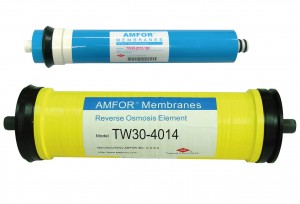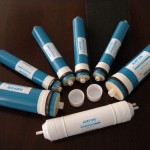TERS OSMOZ MEMBRANLAR
Osmoz, düşük tuz konsantrasyonlu çözeltiden yüksek tuz konsantrasyonlu çözeltiye doğru yarı-geçirgen membrandan suyun kimyasal potansiyelinde denge sağlanıncaya kadar suyun geçişine izin veren doğal bir olaydır.
Denge durumunda, diferansiyel basınç membranın her iki tarafında da osmotik diferansiyel basınç ile aynıdır. Suyun osmotik akışını terse çevirmek için her iki çözeltinin osmotik diferansiyel basıncından daha yüksek dış basınç uygulanmalıdır. Bu ilave dış basınç çözünmüş tuzun sudan ayrılmasını sağlar. Çözünen bir tarafta kalırken, saf çözücünün diğer tarafa geçmesine izin verir. Bu olay ters osmoz (RO) olarak tanımlanır.
Ters osmoz genellikle 3 kategoriye bölünmüştür;
- Yüksek basınç ters osmoz, (5-10 MPa, deniz suyu tuzunun giderilmesi)
- Düşük basınç ters osmoz (2 – 5 MPa, az tuzlu suyun tuzunun giderilmesi)
- Nanofiltrasyon (0.3 – 2 MPa, içme suyunun yumuşatılması)
Membran Özellikleri
Ters osmoz genellikle su için kullanılan filtrasyon işlemidir ve en kompleks membran teknolojisidir. RO, su ve çözücülerin geçmesine izin verirken düşük molekül ağırlıklı organik maddeler ile tuzlar konsantre olur. RO için yüksek basınca ihtiyaç vardır. RO çoğunlukla deniz suyu arıtma ve kuyu suyu arıtmada kullanılır.
Ters osmoz membran, çözücünün (en çok su) seçici olarak geçişine ve diğer çözünmüş maddelerin (genellikle tuz) kısmen ve tamamının alıkonmasına izin vererek hidrolik akışa karşı fiziksel bariyer formunda davranır.
Membran materyal, üretim koşulları ve membran morfolojisi çözünmüş maddelerin alıkonması ve su geçirgenliği için karar verdirici faktördür. Bununla birlikte ayırma temel olarak ters osmoz membranın ince seçici tabakası üzerinde gerçekleşir.

Nanofiltrasyon membranları poröz membran olarak düşünülse de, ters osmoz membranları kapalı nonporöz film olarak tanımlanır. Süzüntü membran materyaline adsorplanır ve yapıdan difüze olur.
Ters osmozda genel olarak tuz alıkonma değeri % 98-99,9 arasındadır. Ters osmoz membranı molekül ağırlığı 150 Dalton’dan fazla olan tüm moleküller tamamen alıkonur.
AMFOR TERS OSMOZ (RO) MEMBRANLARI
Membran tipleri; Poliamit ince film kompozit
 Ev tipi RO Membranlar
Ev tipi RO Membranlar 
AMFOR® ters osmoz membranları ev içme suyu için çok güvenilirdir. Gelişmiş membran teknolojisi ve otomatik üretim bu membranları tutarlı performans ve uzun mesafelere gönderimi için uygun olmasına olanak sağlar. AMFOR ev tipi içme suyu membranları 50 psi’da çalışır ve 60psi’da çalışan rakiplerine göre %20 daha fazla su arıtır.
TW30-1812, TW30-2012, TW30-2812, TW30-3012
 Ticari RO Membranlar
Ticari RO Membranlar
AMFOR® ters osmoz (RO) membranları, küçük ticari sistemler için yüksek kaliteli su sağlar. Bu membranlar farklı ebatlarda mevcuttur. AMFOR TW30XLE-3020-600, TW30XLE-3020-1000 ticari içme suyu makinelerinde en yaygın kullanılan membranlardır.
AMFOR XLE ekstra düşük enerji membranları çok düşük basınçta çalışır böylece en düşük enerji maliyeti ve maliyeti daha düşük sistem elemanlarının kullanımına olanak sağlar.
AMFOR® 4 inç membranları endüstriyel uygulamalar için müşterilerin çok çeşitli ihtiyaçlarını karşılayacak kadar çok çeşitlidir. Yüksek kaliteli su ve düşük enerji maliyetine ilave olarak AMFOR membranları en dayanıklı ve en güvenilir performansı sağlar.
 Endüstriyel RO membranlar ;
Endüstriyel RO membranlar ;
BW30-BWLE400-BW30XLE (-4040), BW30-365, BW30- 400, BW30LE- 440
 Hijyenik RO Membranlar
Hijyenik RO Membranlar
AMFOR RO membranları gıda ve süt sanayisinde 3A uygunluğu gerektiren uygulamaların da dahil olduğu birçok uygulamada kullanılabilir. Bu membranlar suyun uzaklaştırılması ve ürün konsantrasyonu işlemlerinde etkilidir. Tüm bileşenler FDA standartlarına uygundur ve gıda işleme uygulamalarında kullanılır.
RO-3838FF/31, RO-4040FF/31, RO-8040FF/31, RO-8040FF/48
 HSRO Membranlar
HSRO Membranlar
Amfor HSRO membranları üstün kaliteli su sağlar ve sıcak su ile temizlemeye dayanıklı olduğu için önemli özelliğe sahiptir. HSRO membranları endüstride en yüksek aktif membran alanına sahiptir. Atıl kullanım alanlarını minimize eder ve hijyenik çalışmalar için uygundur. FDA standartlarına uygundur.
HSRO-4040FF; HSRO-390FF
 Deniz suyu RO Membranlar
Deniz suyu RO Membranlar
SW30 2514, SW30 2521, SW30 2540, SW30 4021, SW 4040


